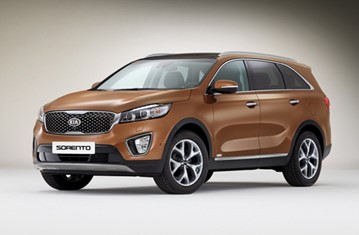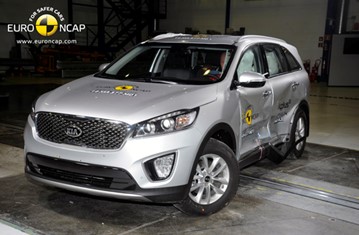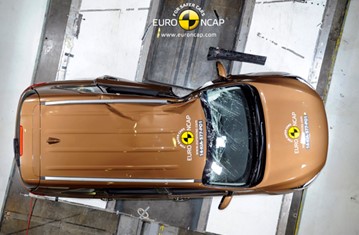Find more information in the General Comments section of the assessment
Find more information in the Rating Validity tab of the assessment
- See More
- See More
- See More
- See More
- Good
- Adequate
- Marginal
- Weak
- Poor
 Passenger
Passenger
 Driver
Driver
 Rear Seat
Rear Seat
 Front Seat
Front Seat
 Car
Car
 Pole
Pole
- Good
- Adequate
- Marginal
- Weak
- Poor


Passenger
outboard
center
outboard
Fitted to the vehicle as standard
Not fitted to the test vehicle but available as option
Not Available
-
Infants up to 13 kg
-
Infants and toddlers up to 18 kg
-
Toddlers from 9 to 18 kg
-
Toddlers over 18 kg
Easy
Difficult
Safety critical
Not allowed
| Seat Position | ||||||
|---|---|---|---|---|---|---|
| Front | 2nd row | 3rd row | ||||
| Passenger | Left | center | Right | Left | Right | |
| Maxi Cosi Cabriofix (Belt) | ||||||
| Britax Römer King Plus (Belt) | ||||||
| Britax Römer Duo Plus (ISOFIX) | ||||||
| Britax Römer KidFix (Belt) | ||||||
| Maxi Cosi Cabriofix & EasyFix (Belt) | ||||||
| Maxi Cosi Cabriofix & EasyFix (ISOFIX) | ||||||
| BeSafe iZi Kid X3 ISOfix (ISOFIX) | ||||||
| Maxi Cosi Pearl & Familyfix (ISOFIX) | ||||||
| Britax Römer KidFix (ISOFIX) | ||||||
Easy
Difficult
Safety critical
Not allowed
Based on dummy readings in the dynamic crash tests, the Sorento scored maximum points for its protection of the 1½ year dummy, sat in a rearward-facing restraint. In the frontal impact, forward movement of the head of the 3 year dummy, sat in a forward-facing restraint, was not excessive but neck and chest forces were marginally high. In the side impact test, both dummies were properly contained within the protective shells of their restraints, minimising the likelihood of dangerous head contact with the vehicle interior. The front passenger airbag can be deactivated to allow a rearward-facing child restraint to be used in that seating position. Clear information is provided to the driver regarding the status of the airbag and the system was rewarded. All of the restraint types for which the car is designed could be properly installed and accommodated in the car.
- Good
- Adequate
- Marginal
- Weak
- Poor

Head Impact 18.3 Pts
Pelvis Impact 0.0 Pts
Leg Impact 5.9 Pts
The bumper showed good or adequate protection to pedestrians' legs. However, the front edge of the bonnet scored no points, providing poor protection to the pelvis region. The Sorento has an active bonnet. When sensors detect that a pedestrian has been struck, actuators lift the bonnet, providing extra clearance to the stiff structures in the engine bay. Kia showed that the system operated robustly for a variety of pedestrian statures and over a broad range of speeds. Therefore, Euro NCAP's tests were performed with the bonnet in the raised (deployed) position. Tests results on the bonnet surface were predominantly good or adequate with poor results recorded only at the base of the windscreen and on the stiff windscreen pillars.
- Good
- Adequate
- Marginal
- Weak
- Poor
| Speed Limit Information Function | Camera & Map |
| Speed Limitation Function | Manually Set |
| System Name | ESP | |
| Performance | ||
| Applies To | All seats | ||
| Warning | Driver Seat | Front Passenger(s) | Rear Passenger(s) |
| Visual | |||
| Audible | |||
|
|||
| Type | Lane Departure Warning |
| Performance | |
|
LDW Confirmation Test
|
Pass |
Electronic stability control is standard equipment on the Sorento, together with a seatbelt reminder for the front and rear seats. A lane departure warning system is an option. It is expected to be fitted to most cars sold so it was included in the assessment and met Euro NCAP's requirements. A speed assistance system combines information from digital mapping with a speed-sign recognition camera to determine the speed limit at any point whilst driving. The driver is informed and can choose to set the speed limiter appropriately. The system met Euro NCAP's requirements and was rewarded. An autonomous emergency braking system is not available for the Sorento.
- Specifications
- Safety Equipment
- Videos
- Rating Validity
Specifications
Tested Model Kia Sorento 2.2 diesel GLS, LHD
Body Type - 5 door SUV
Year Of Publication 2014
Kerb Weight 1843kg
VIN From Which Rating Applies - applies to all Kia Sorentos of the specification tested
Class Large SUV
Safety Equipment
Note: Other equipment may be available on the vehicle but was not considered in the test year.
Fitted to the vehicle as standard
Fitted to the vehicle as option
Not fitted to the test vehicle but available as option
Not Available
Not Applicable
Videos
Rating Validity








Find more information in the General Comments section of the assessment
 Share
Share










The passenger compartment remained stable in the frontal impact. Dummy readings indicated good protection of the knees and femurs of the driver and passenger. KIA showed that a similar level of protection would be provided to occupants of different statures and to those sat in different positions, whose knees might contact the dashboard in different places. In the side pole test, protection of all critical body regions was rated as good and the Sorento scored maximum points. Even in the more severe side pole test, maximum points were scored, with good protection of all body areas. Tests on the front seats and head restraints indicated good protection against whiplash injuries in the event of a rear-end collision. A geometric assessment of the rear seats, including the optional third row, also indicated good whiplash protection for these seating positions.